SI Vault: As team faces uncertainty, Saints rush to help NOLA after Katrina

In the days after Hurricane Katrina hit New Orleans, NFL.com's Michael Silver, then with Sports Illustrated, traveled to the heart of destruction with Deuce McAllister of the New Orleans Saints. This story originally ran on SI.com the week after the storm in 2005, and we are republishing it today in remembrance of the 10th anniversary of the storm.
He had a story to tell, like so many tens of thousands of others who were battered by Hurricane Katrina and endured its calamitous aftermath, and the New Orleans native with short dreadlocks and numerous gold teeth did not sugarcoat it for his famous listener. The man’s name was Michael Verrett, and after he related his weeklong ordeal to Deuce McAllister while waiting to be evacuated from Louis Armstrong International Airport last Sunday, the Saints’ star halfback merely shook his head and whispered, “Wow.”
McAllister and I had been escorted into New Orleans by three Salvation Army workers last Sunday, and now we were talking to survivors of what will likely rank as the worst natural disaster in U.S. history. While walking through the terminal, McAllister had been recognized by Verrett’s adolescent son, Michael Jr., who’d initiated a conversation about the Saints and their upcoming 2005 season, which surely will set a new standard of displacement for the modern major professional sports team.
“Hey Deuce, over here might be the next superstar Saints running back,” the elder Verrett said proudly while playfully punching his son. Then, addressing Michael Jr., he added, “See, I’m telling you, look at this man. If you want to be a running back, you’ve got to eat.”
How sports have helped New Orleans heal in decade since Hurricane Katrina
Nourishment had been a constant worry for the previous six days, as father and son were holed up in a crowded shelter at Charles R. Drew Elementary School in New Orleans’s Bywater neighborhood. There they tried to survive amid flooding, chaotic crime and the absence of power and running water. Verrett told of stretching the school’s limited food supply by “making giants pots of beans… Some of us swam to our houses and got butane tanks and pots and pans and brought ‘em back, and we took car batteries and cut the wires to set it up so we could cook.”
The meals, he said, mostly went to the elderly and the children. “I was hungry many nights,” Verrett said, rubbing his son’s head, “but as long as I saw this guy here lying down with something in his stomach, my stomach was full.”
The people at the shelter kept up with the crisis by jerry-rigging car batteries and hooking up radios. Another woman sitting with Verrett said that “the military people let us break into a Walgreens and get diabetes medicine for my auntie, along with food and water. I ain’t never stole nothin’ in my life before, but I stole a bus and loaded it up with food, water and medicine and drove around the neighborhood delivering it to people who needed it.”
Verrett said he and the other men at the shelter served as a makeshift police force, attempting to ensure that the elderly and kids were cared for first. “We had some bad things happen,” he said. Then Verrett, somewhat remarkably, told of a reasonably prominent New Orleans singer who “opened her house, gave us all the food and water. To show she supported us she came over to the shelter and slept among us, on the roof. But then a couple of guys got carried away.” Those men, Verrett said, raped the singer in the middle of the night, one of at least two sexual assaults that he said happened there over the course of the week.
“We got rid of them the next day,” Verrett said. “We weren’t having that. The other men and I had to be soldiers and join together to protect our women. We spliced the battery wires and set up lights where the women were sleeping so it wouldn’t happen again.”
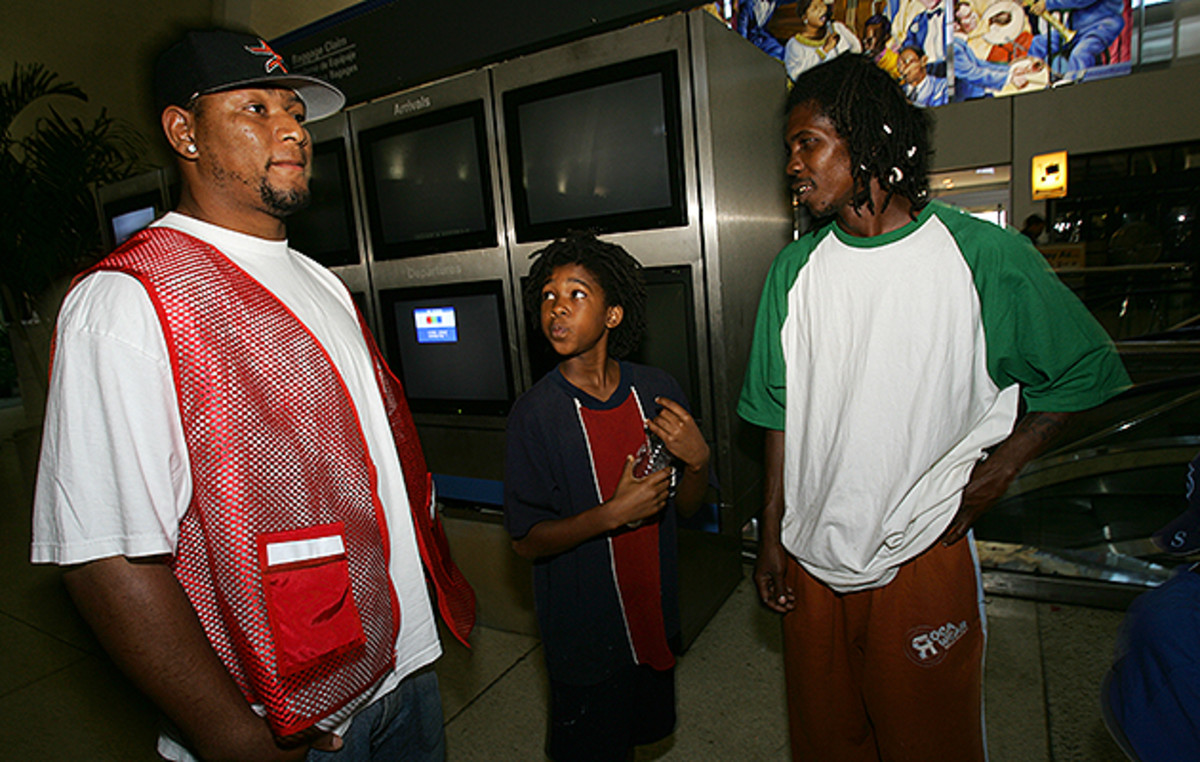
We said our goodbyes, and then McAllister and I walked outside to the trash-filled road outside the terminal. We weren’t sure if Verrett’s story had been entirely true—and of course we prayed especially that the last part wasn’t—but neither of us doubted that he’d experienced something far more hellish than either of us could ever have imagined. We walked farther along the road and watched evacuees disembarking from military helicopters, walking slowly along the tarmac while carrying belongings in white, plastic trash bags.
“Did you see the movie ‘Hotel Rwanda’?” McAllister asked. “That’s what this looks like.”
Soon we were downtown, standing atop Interstate 10 at a major downtown intersection: Canal St. and Claiborne Ave., each of which was flooded with several feet of water for as far as the eye could see. We had conversations with numerous survivors who expressed no interest in leaving, including an old man living in a broken-down Greyhound Bus parked on the interstate. Two of the Salvation Army officials and McAllister entered the bus to implore the man to leave, but he refused. “I’m waiting here for my family to get back,” he said. “I ain’t going anywhere without them.”
Nearly 72 hours earlier I’d arrived in Oakland to watch the Saints, who’d shipped out to the Bay Area before the hurricane hit, go through the motions in last Thursday night’s preseason finale, which they lost to the Raiders by a 13–6 score. Coach Jim Haslett then gave his players until 11 p.m. Sunday to tend to their affairs before reporting to the team’s new headquarters at a San Antonio hotel. In an effort to capture the madness of the moment I flew to Houston, where on Saturday morning I accompanied wideout Joe Horn on a three-hour visit with evacuees at the Astrodome. Then I caught a flight to Jackson and hooked up with McAllister and fellow running back Fred McAfee, who visited shelters in that area, dropping off big-screen TVs and DVD players they’d purchased and casually co-mingling with their displaced brethren.
On Sunday morning McAllister and I—along with photographer Bill Baptist and Salvation Army Major Mark Woodcock, public relations whiz Mark Jones and associate director of development Caeser Grantham—hopped into a green Chevy Astro van and headed into the heart of the devastation.
Here are some of my experiences and recollections from a heartrending weekend I’ll never forget:
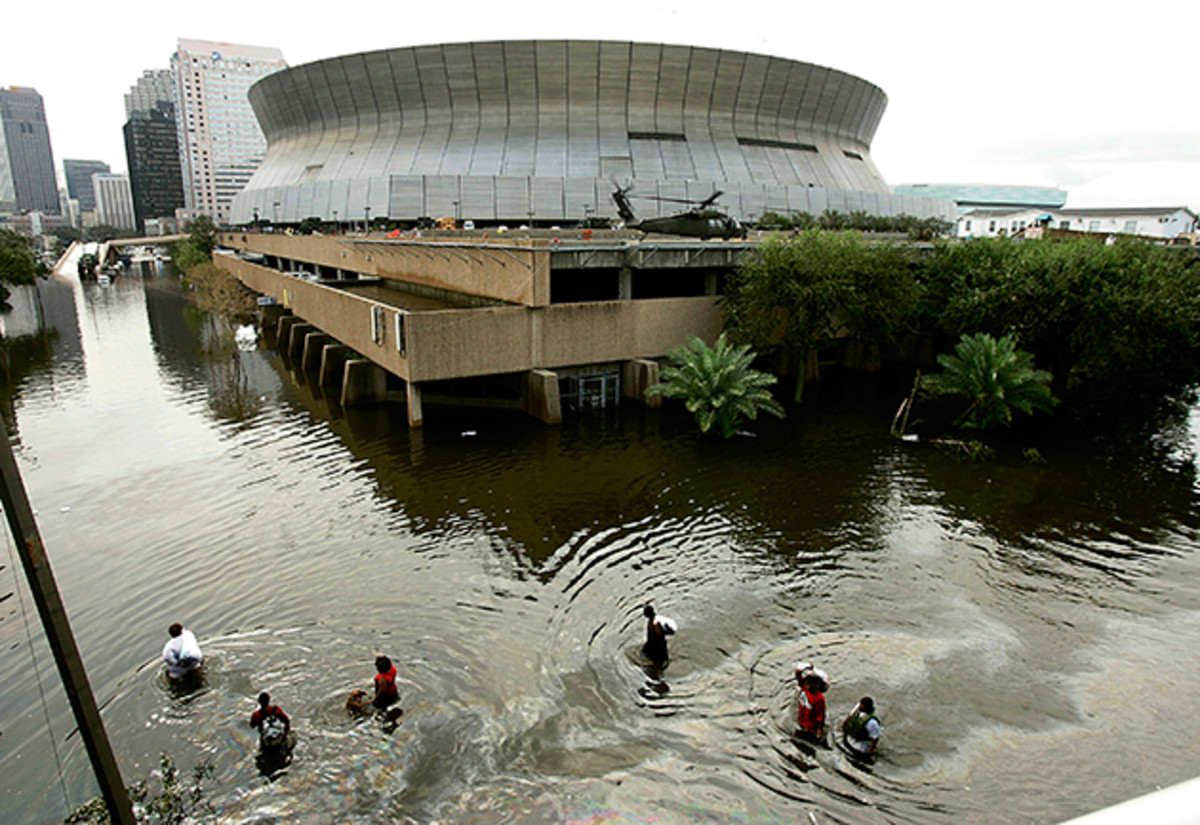
THE L-WORD
In times of trauma, as with the aftermath of 9/11, there is a school of thought that the resumption of professional sports can help people recover from tragedy. Five days after Katrina ravaged New Orleans and other spots along the Gulf Coast, Joe Horn wasn’t buying it.
“Football?” he asked with the same degree of incredulity with which former Saints coach Jim Mora once famously spoke of PLAYOFFS?. He then made a dismissive noise that sounded roughly like, “Tcccccch.”
“Nobody on our team is thinking about that right now, and that’s natural,” he continued as we drove into the Astrodome parking lot. “We damn sure ain’t talkin’ about the Raiders.”
But over the next several hours, as the veteran receiver flamboyantly, unhurriedly made his rounds through the cot-lined Dome, Horn underwent a curious transformation. So many of the evacuees, most of whom had endured miserable conditions at the Superdome before being relocated to Houston, were excited to see him—and eager to talk about the Saints—that he became both energized and galvanized. “That’s what they want—a chance to see us play,” Horn would marvel later. “They want us to roll. I thought football would be irrelevant right now. It’s not. Now I’m more spirited and ready to go back and do my job than I was before, and I’ll be telling all the other guys what I felt here.”
Horn, best known for the 2003 touchdown celebration in which he produced a cell phone and tried to place a call from the end zone, is an ebullient, unpretentious personality who brightened many a mood on Saturday. One young man was so excited to see Horn that he followed him around for several minutes, issuing increasingly exaggerated proclamations of the player’s greatness.
“Joe Horn can catch a 150-yard pass, man,” he yelled at one point. “I ain’t lyin’. Me and Joe Horn are going to Detroit; you heard me?”
Ten years since Katrina: Oral history of the Saints and their Superdome
Signing everything from dirty pillows to babies’ onesies to pocket bibles—even one man’s photo of his missing wife—Horn was a beacon of optimism, telling siblings to “take care of each other” while stressing that the Saints would return to a rebuilt, revived city. “Hey, the water’s gonna go away,” Horn told a diabetic man who remained bedridden and hungry, having had to refuse the carbohydrate-laden doughnuts being passed out by rescue workers. “We’re still gonna have our crawfish boils.”
There were heavy moments. One man in his early 20s burst into tears upon encountering Horn and locked him in a long embrace. “We’re not hearing how truly brutal it is on the news,” Horn had told me earlier. “I talked to people who were inside the Superdome; they said that after the man jumped [from the balcony], they left his body there, with blood pouring out of his head, for three days.”
At the Astrodome a woman told Horn of raising her 15-month-old daughter over her head to avoid chest-high floodwaters before being rescued; another related a tale of returning to her flooded home to retrieve a few belongings and, while emerging from the house with her children, having a shotgun pointed at her chest by a police officer who suspected her of being a looter.
The L-word (much like the R-word: refugee) was a touchy subject among Horn and many of his African-American teammates, who bristled at the media focus on behavior that the players considered to be largely understandable given the circumstances.
“These people were left there for days by the government, with no food or water, just trying to survive,” Horn said after the Raiders game. “Hell, if I’d been trapped there, you’d be calling me a looter, too. Picture watching your little sister drown and you’re scared and hungry and you don’t have any shoes, and now two hours later you see a Wendy’s or a Footlocker. What would you do?
“You know what I’d like to say to everyone stuck there? Loot MY house. Seriously, I have a nice house in Destrehan that’s full of stuff, and anyone who wants it can have it. Go on in and take my flat-screen TVs and raid my refrigerator. Whatever.”
• NIESEN: Tulane football remembers Hurricane Katrina, 10 years later
Lest you regard Horn as merely a talker, he headed immediately for the bank after leaving the Dome. He had been up until 4 a.m. the previous night fielding calls for help, some from people to whom he was only vaguely connected, and now was preparing to wire thousands of dollars to many of them. (The previous Saturday Horn had received a call from the mother of his high school sweetheart. His ex-sweetheart’s sister, to whom Horn had not spoken in 20 years, and her husband were visiting New Orleans; with their flights cancelled and no rental cars to be found, they were stranded as Katrina approached. Horn drove to their hotel, picked them up and arranged for a driver to take them to safety in Atlanta. The woman, Aleta Quinones, later emailed the story to CNN, referring to Horn as a “hero” and a “Saint.”)
As he left the Astrodome and headed off to deplete his bank account further, Horn was the happiest he’d been since the hurricane hit. “Those people in there were so upbeat, much more so than I expected,” he marveled. “I guess they have to be; they’ve got kids looking up to them, so even if they have to front they have to give their kids some hope. I feel way better now, man, because I see kids smiling.
“These people supported the New Orleans Saints when the water wasn’t there, and now I’m here to support them. I came because I wanted to feel their heart. And what I found was that they still want us to win—maybe because that’s what they have to hold onto. I can take that back to the guys on the team. Now I can go to Carolina [for next Sunday’s season opener] with a clear conscience.”
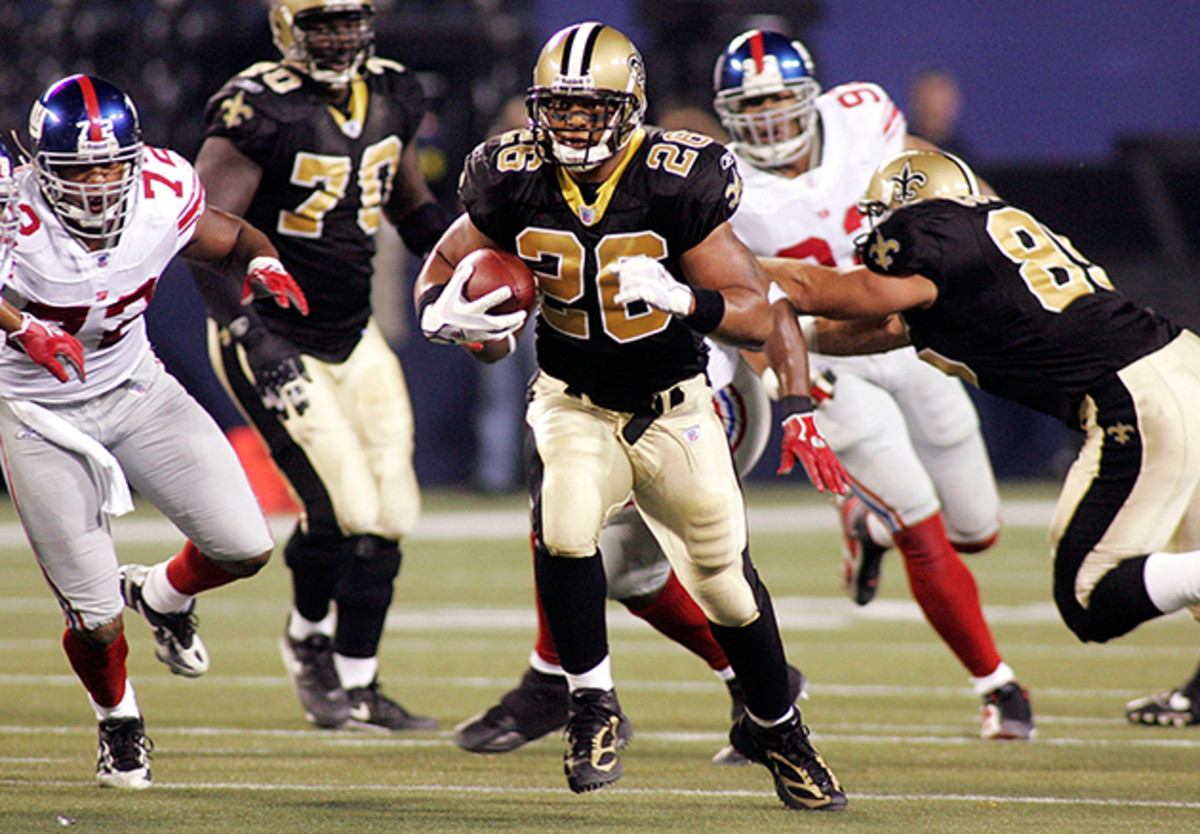
HANGING BY A THREAD
For all of the purposeful emotion Horn and other Saints players now vow to carry into the regular season, they were a fractious bunch early last week as the haunting impact of Katrina became clear. After Haslett and general manager Mickey Loomis went over some logistics last Tuesday at the team’s hotel in Fremont, Calif. (where the Saints had set up shop in advance of the Raiders game), several players took turns objecting to the schedule, some demanding that they refuse to play against Oakland while coping with the hurricane’s ramifications.
“You need to tell Paul Tagliabue to cancel this game,” one player said to Haslett and Loomis.
Things got increasingly heated until veteran offensive tackle Wayne Gandy spoke up. “You all need to realize—we’re the fortunate people,” he told his teammates. “Some of us might have lost our houses, but there are people who’ve lost everything.”
As the tragedy played out, Gandy and other Saints were mortified by what they perceived as the government’s slow response. Race was a subtext to many of their reactions, as was the larger class issue.
“[Almost] a third of New Orleans was poverty-stricken, and that’s what I think America is being awakened to by this storm,” Gandy said after Thursday’s game. “It’s one of those cities that was always kind of holding on by a thread. People think of New Orleans as the Big Easy, with all that partying, but a third of the city was poor, and now people are seeing the result of that. People couldn’t leave. I don’t think the guy who lives in a high-rise in New York City can understand that.”
[pagebreak]
MIXED BLESSINGS
I’ve known Fred McAfee since the mid-1990s, when he was a young special teams demon for the Pittsburgh Steelers, and during the decade that followed he has never once failed to smile in my presence. But last Saturday afternoon, as he and McAllister visited a shelter in Byrum, Miss., the Saints’ 37-year-old backup halfback told a story that got us both choked up.
“I was watching ‘Nightline’ last night as I was getting ready to go to sleep, and they had some footage of these people getting let out of a [military] helicopter,” McAfee said. “And all of a sudden I said, ‘That’s my niece!’”
McAfee’s brother’s five-year-old daughter, Jaihana McAfee, had been trapped in the city along with her mother and maternal grandparents, and the rest of the family had been vainly trying to locate them for days. McAfee called to tell his brother of the five-second clip he’d seen; soon another friend called McAfee’s brother with a similar report.
The good news, of course, was that Jaihana, who was seen disembarking from the copter with her grandparents, was alive. The bad news was that, after five days of presumably being trapped in a house, the girl was being dropped off at the makeshift staging area on Causeway Blvd. in Metairie, where more than a thousand refugees were vying for assistance.
As McAfee expressed concern for his niece’s safety, a loud commotion was about to take place outside, in the parking lot of the Crossroads of Life Church. Minutes later a young man named Vernon Dotson Jr. emerged from a car and, after having been missing for six days, had an emotional reunion with his parents as scores of onlookers cheered wildly.
Having been stranded in New Orleans’s Ninth Ward, Dotson didn’t want to discuss his activities during that time. “I survived,” he said simply. “What I did, I can’t say.”
His father, Vernon Sr., who’d just driven south to Natchez to pick up his son at the shelter to which the boy had been traced, looked as happy and relieved as any human I’ve ever seen. “When you come to the knowledge that you can’t do it alone,” he said, looking skyward, “you turn it over to Him. That’s what He wanted all along. We are survivors, that’s what we are.”
Back inside, McAllister was signing the wheelchair of a one-legged man from New Orleans who refused to complain about his own predicament. “Hey, I got out—in my condition it didn’t make sense to hang around,” he said. “I’m truly blessed.”
TEN YEARS LATER: THE SAINTS AND KATRINA
Ten Years Later: The Saints and Katrina
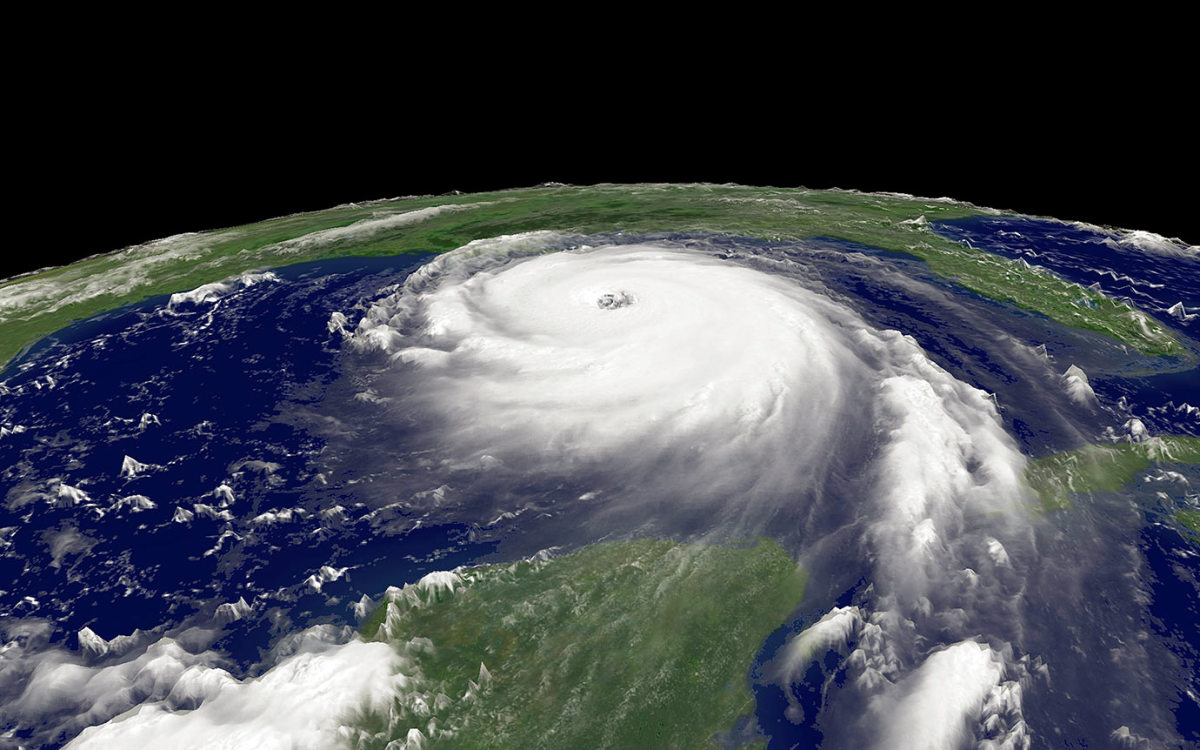
Aug. 26, 2005: Meteorologists warn citizens in the Gulf States that a major storm is on its way. Louisiana Governor Kathleen Blanco declares a state of emergency, and the White House begins deploying National Guard troops to the region.
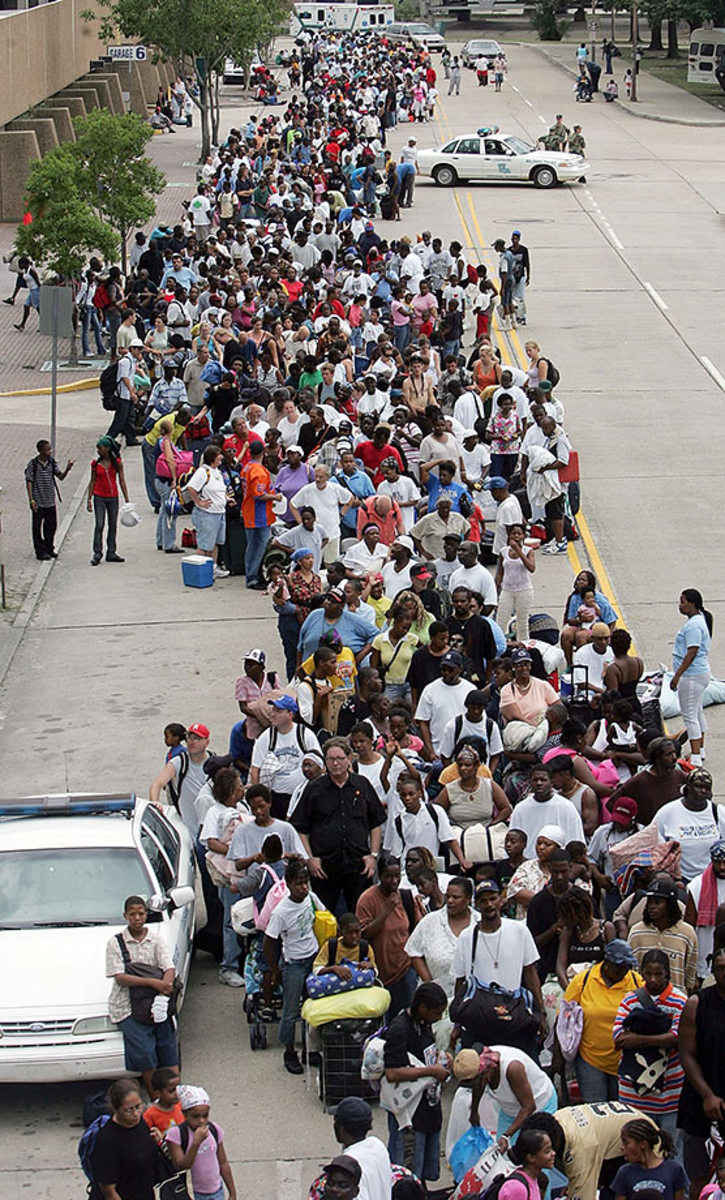
Aug. 27, 2005: The Superdome transitions from house of fandom to house of refuge. Hurricane Katrina winds reach 115 mph and increases to a Level 3 intensity. Local citizens begin to leave New Orleans.
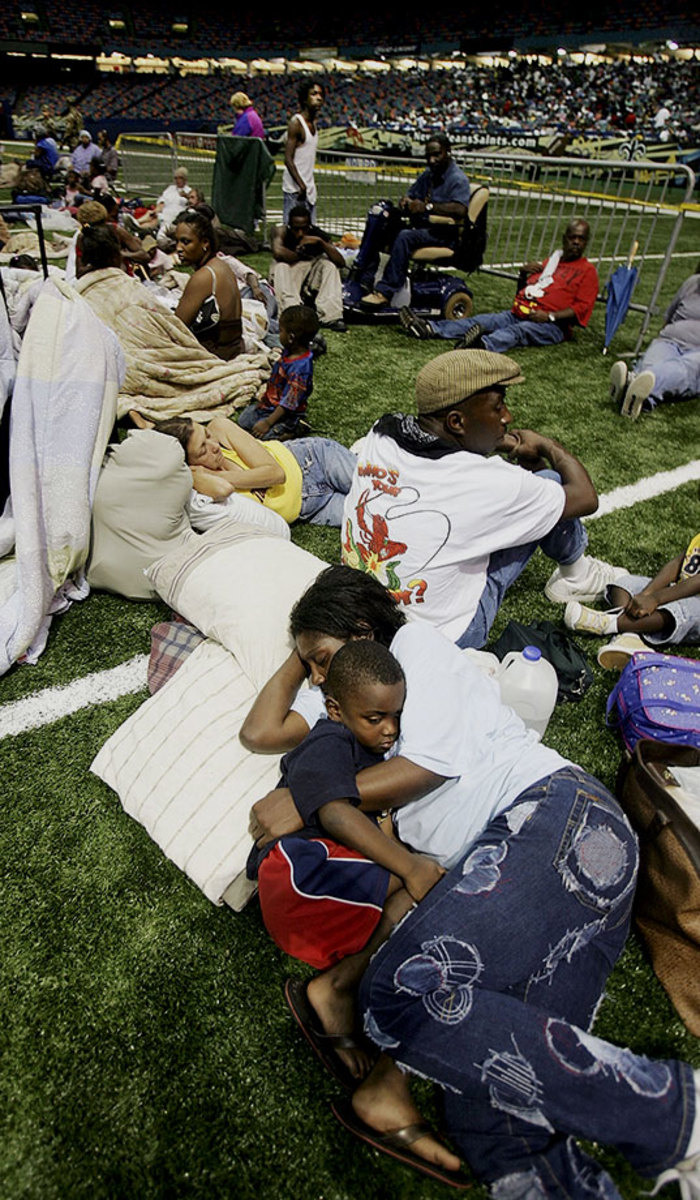
Aug. 28, 2005: Katrina becomes a Category 5 storm with winds swirling at 160 mph. In the morning, New Orleans mayor Ray Nagin orders a mandatory evacuation of the city. About 14,000 residents unable or unwilling to leave New Orleans take shelter at the Superdome.
August 2005
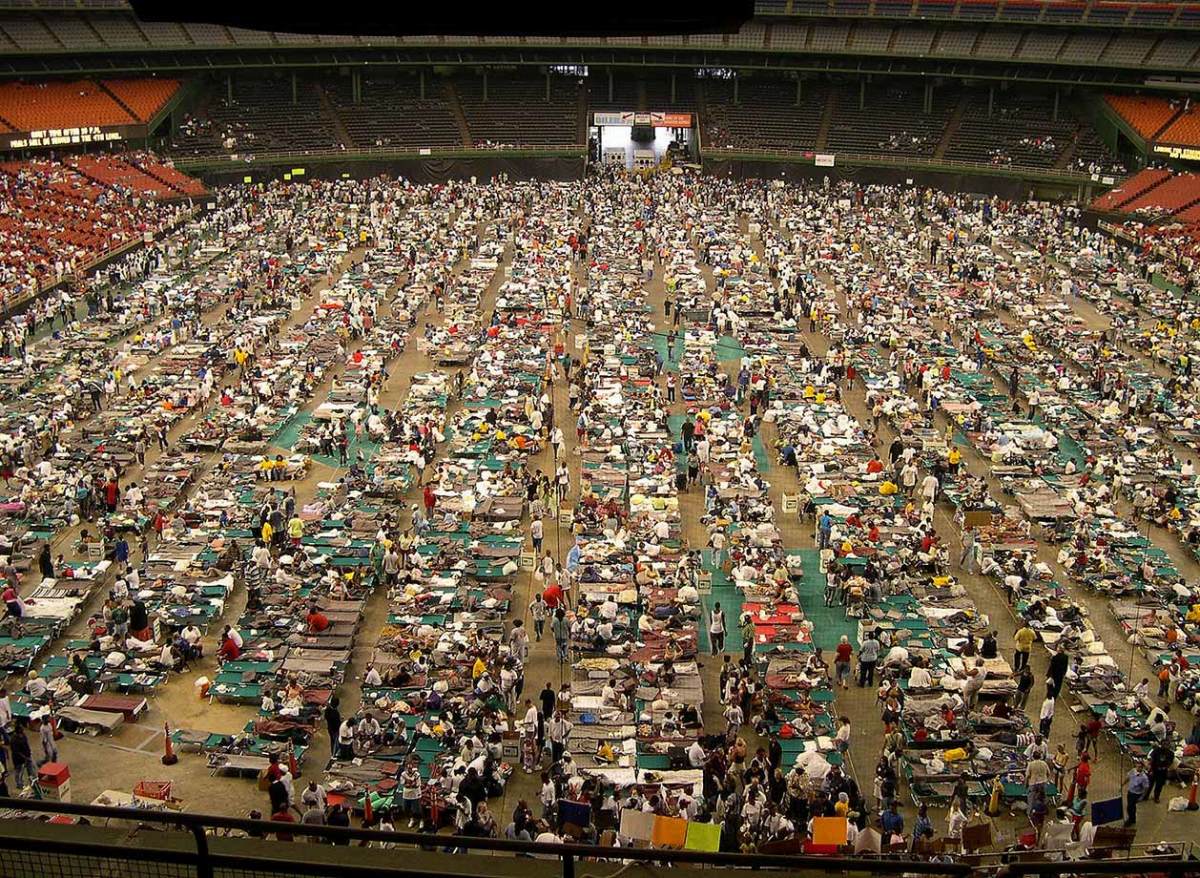
That number swells to 30,000 in the days that follow.
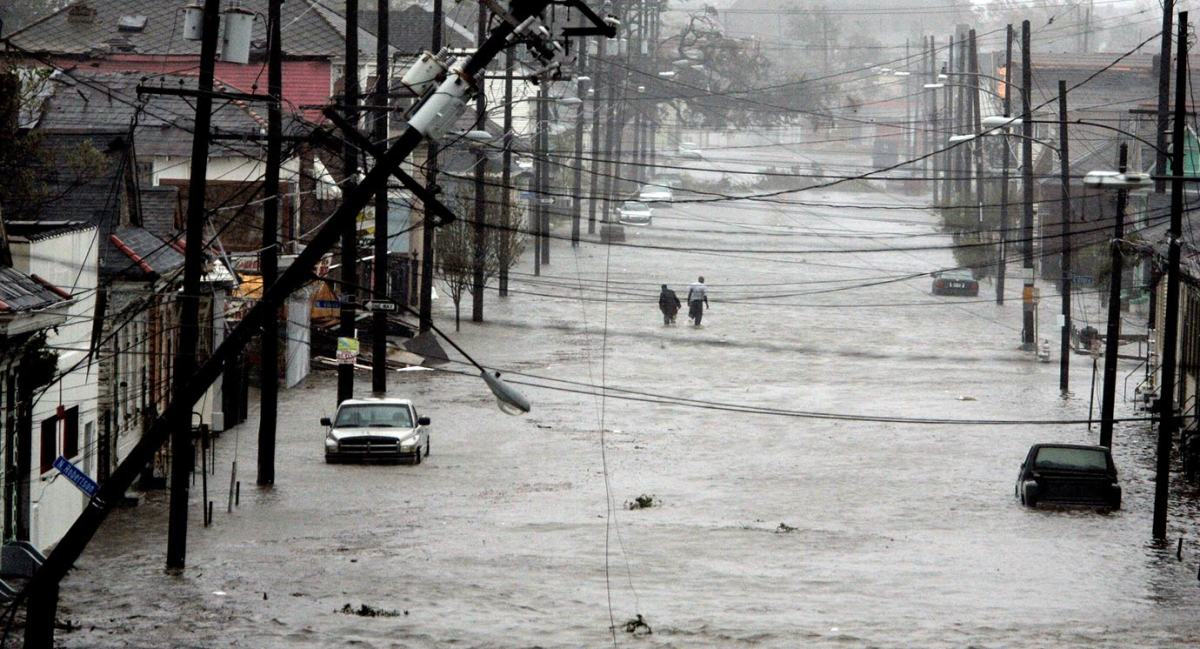
Aug. 29, 2005: In the early hours Category 4 Hurricane Katrina makes landfall. By 8 a.m. the storm eye's passes through New Orleans and the sense is that the city has avoided a catastrophe. But just two hours later, reports surface that levees in the Ninth Ward are overtopped. By late morning, a large section of the 17th Street Canal levee is breached and the city begins to flood.
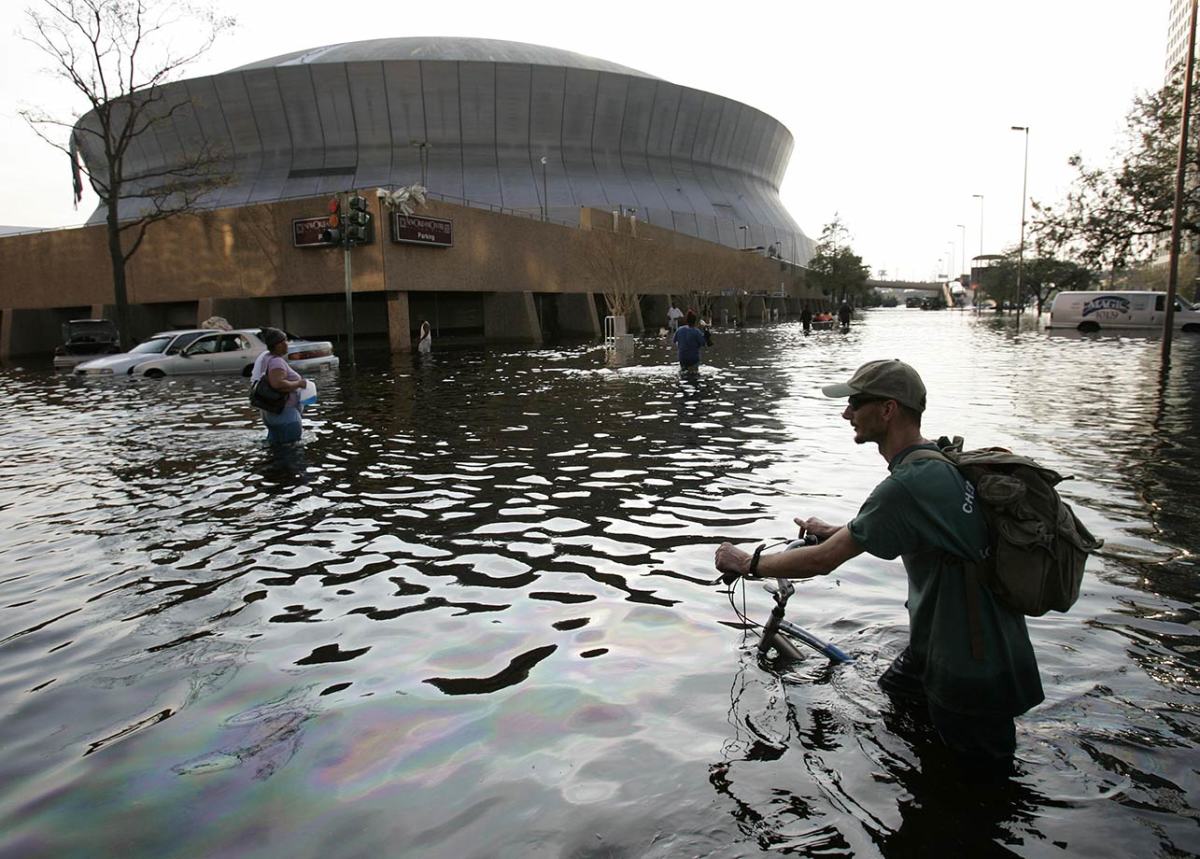
Aug. 31, 2005: A man pushes his bicycle through flood waters near the Superdome. Hurricane Katrina left much of the city under water. Officials called for a mandatory evacuation of the city, but many resident remained in the city and had to be rescued from flooded homes and hotels.
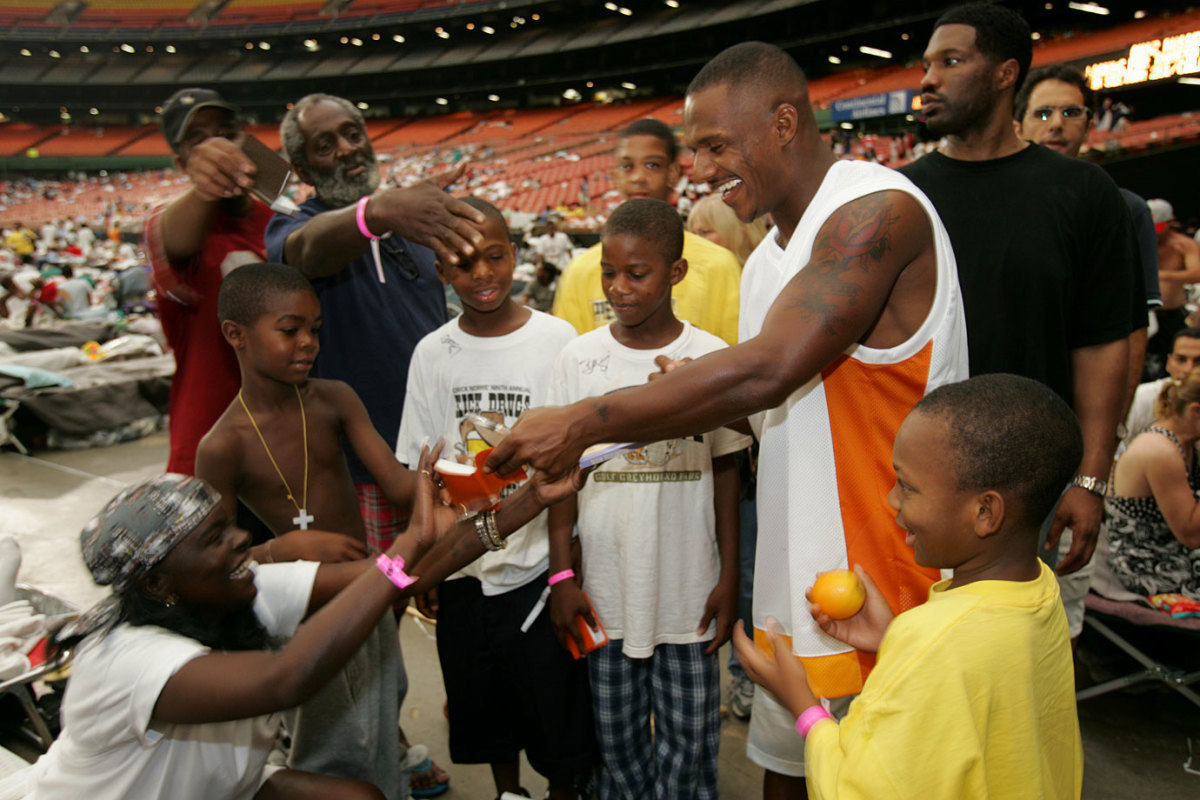
Sept. 3, 2005: Saints wide receiver Joe Horn visits evacuees sheltered in the Astrodome. "At the Astrodome it was like a refugee camp," said Horn. "It was just sad. But when the kids ran up to me I got more excited about playing football."
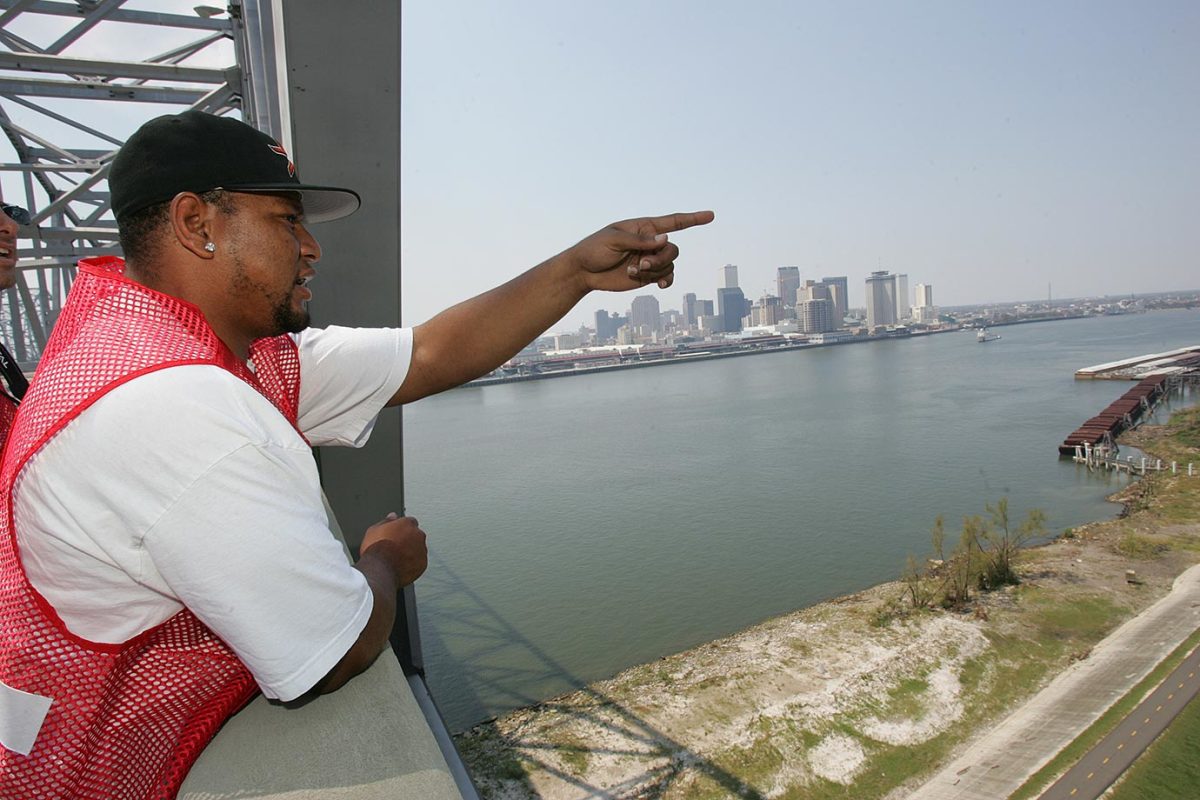
Sept. 4, 2005: Saints running back Deuce McAllister surveys the damage in New Orleans after Hurricane Katrina. "I had an opportunity to go back that Saturday and do stuff for the Red Cross," said McAllister. "Even to think we considered these people refugees. They were not refugees; they were people who lost their homes. When someone loses their home in a fire we don’t use that term. These people were American citizens who just lost their homes. To think they could not get help. To think we were responding in the manner we were was really mind-boggling."
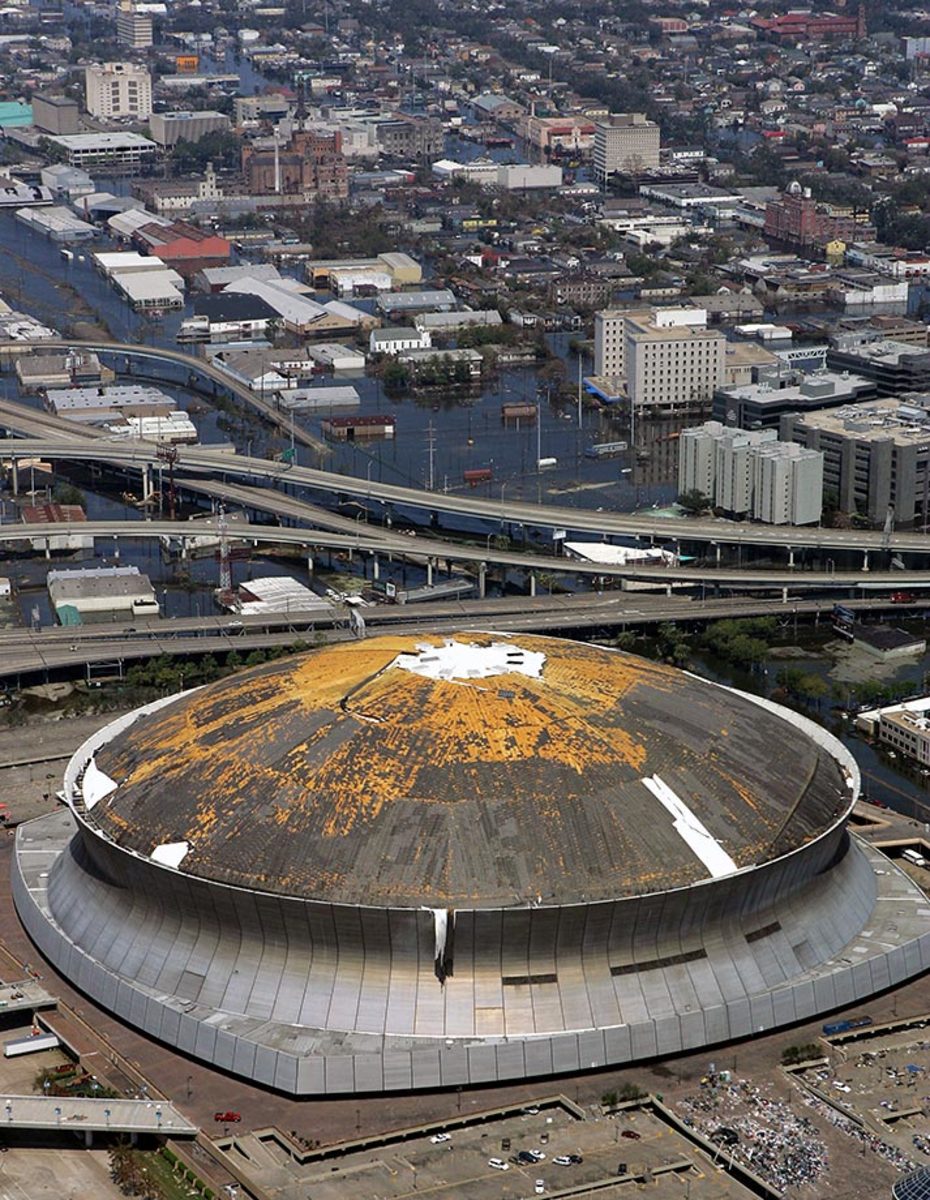
Sept. 12, 2005: The Saints, left searching for a host site after Hurricane Katrina ravaged the Superdome roof, announce plans to split seven home games this season between Tiger Stadium in Baton Rouge and the Alamodome in San Antonio.
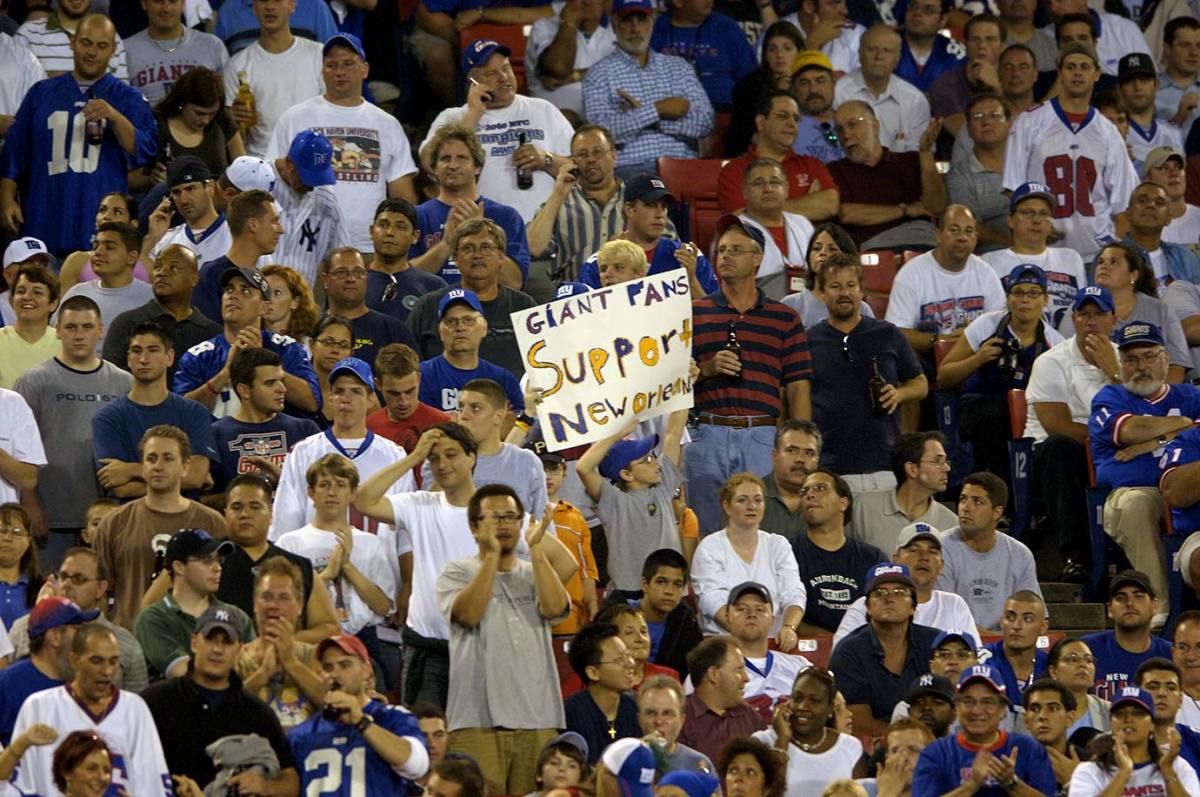
Sept. 19, 2005: The Saints play their first regular season home game at Giants Stadium. Against the Giants. As storm damage is assessed, uncertainty about the team's future looms.
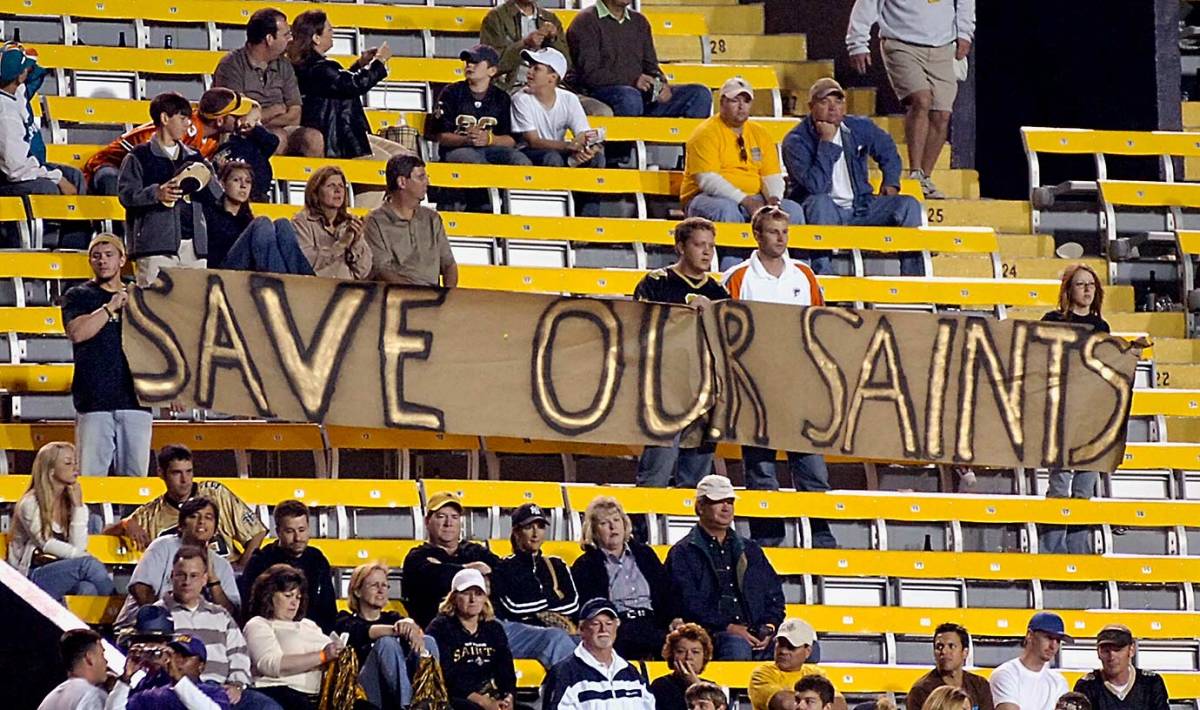
Oct. 30, 2005: Saints fans unfurl a "Save Our Saints" banner in the closing moments of the team's 21-6 loss to the Miami Dolphins at LSU's Tiger Stadium in Baton Rouge, La.
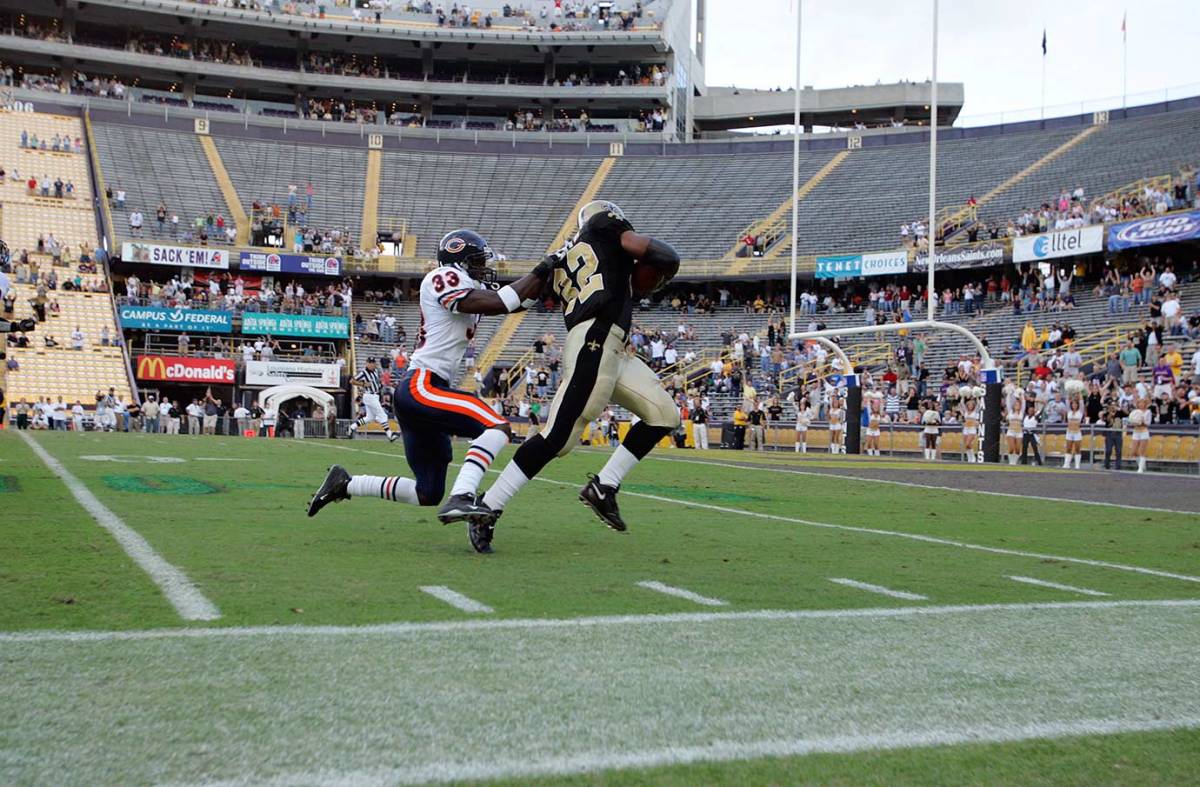
Nov. 6, 2005: Saints running back Antowain Smith is tackled by Bears cornerback Charles Tillman during a game at LSU's Tiger Stadium in Baton Rouge, La. The Bears won 20-17 on a last-second field goal.
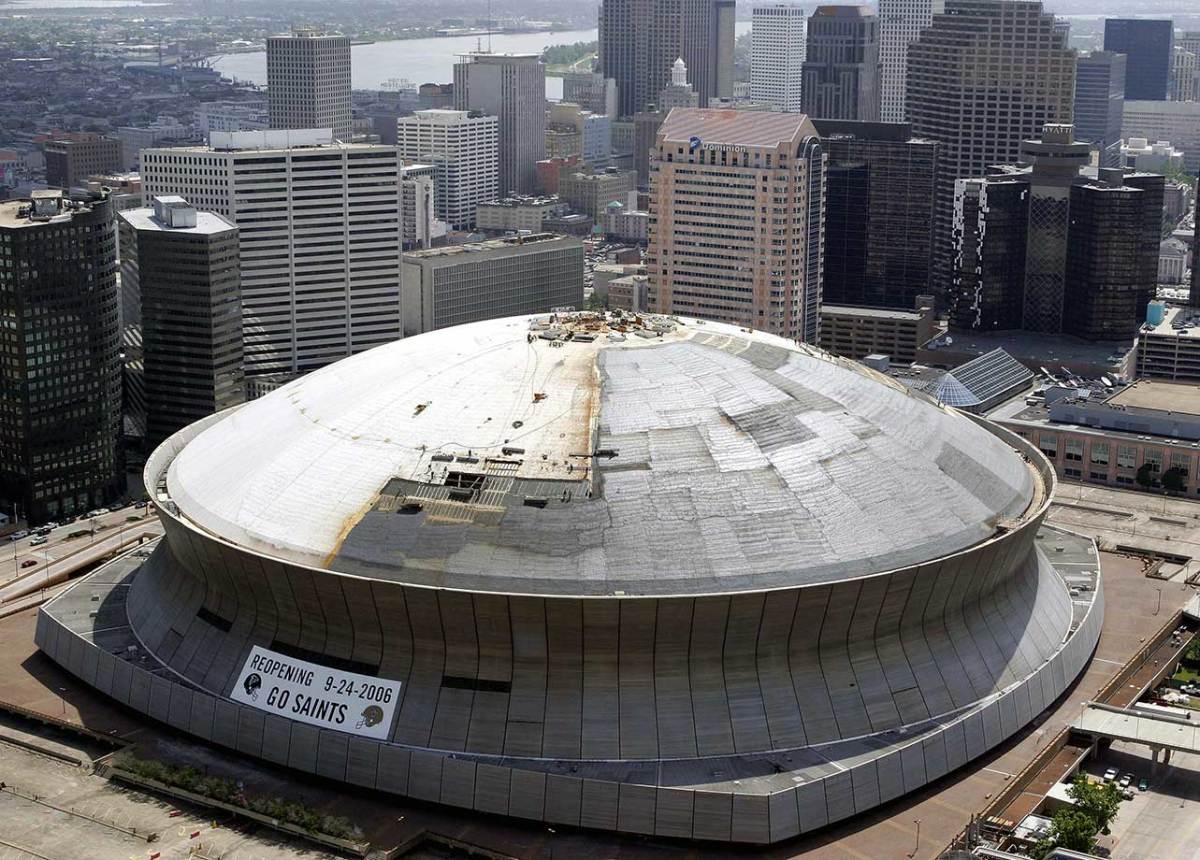
Dec. 30, 2005: The Saints announce they are coming back to the Superdome in 2006.
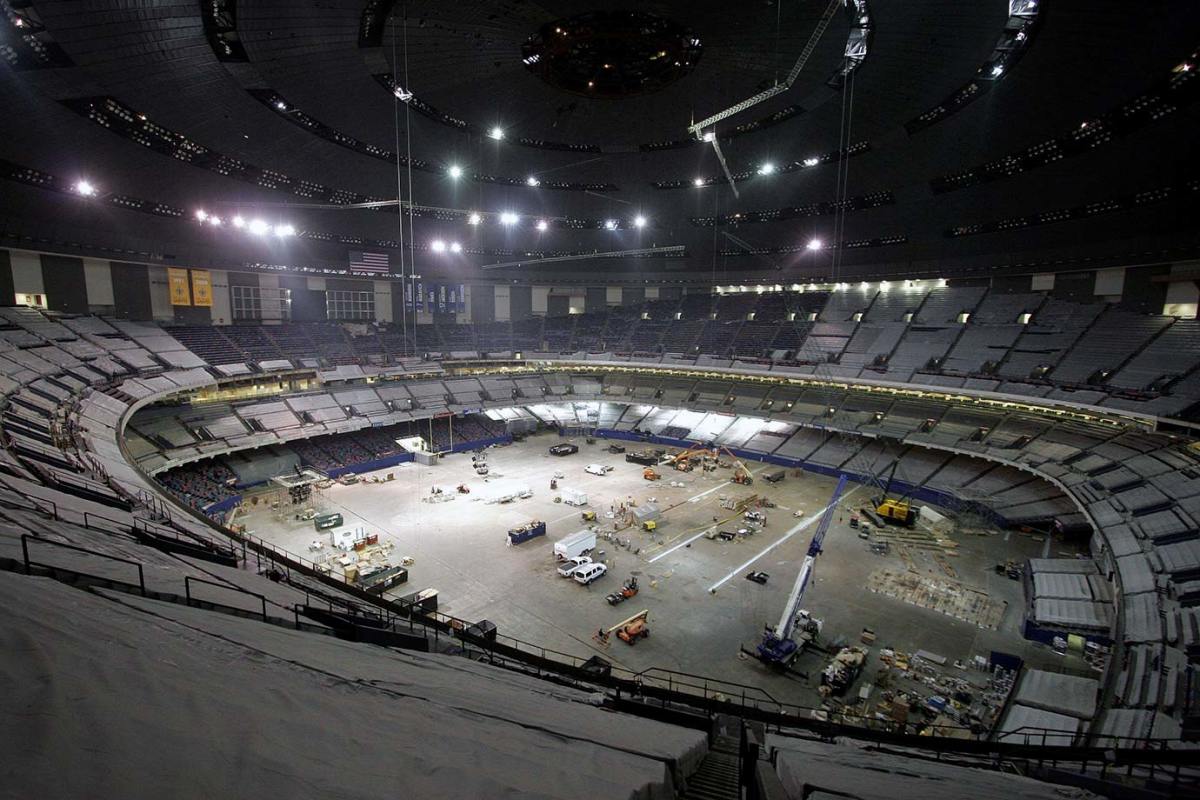
Aug. 8, 2006: Repairs and renovation work is still being done on the Superdome.
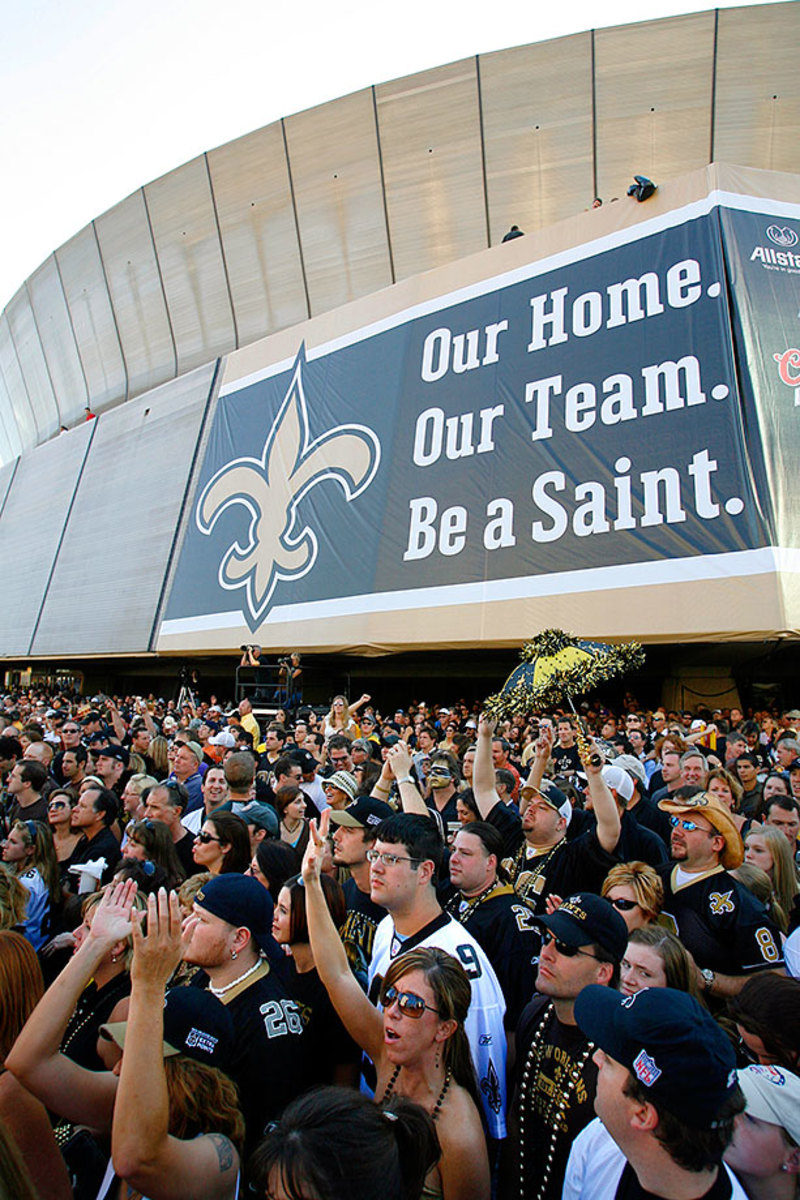
Sept. 25, 2006: With 70,000 fans and supporters gathered from around the globe, the Saints make an emotional return to the Superdome to play the Falcons.
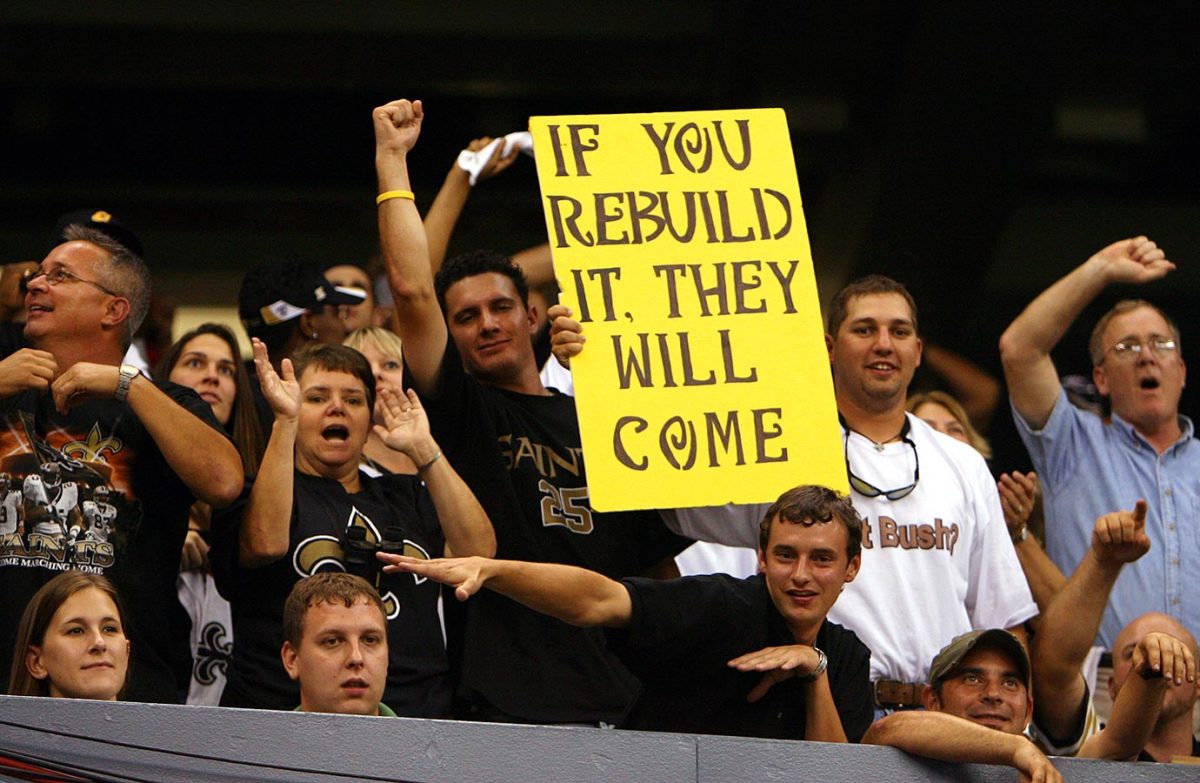
Sept. 25, 2006: Saints fans cheer before the team's first game back at the Superdome.
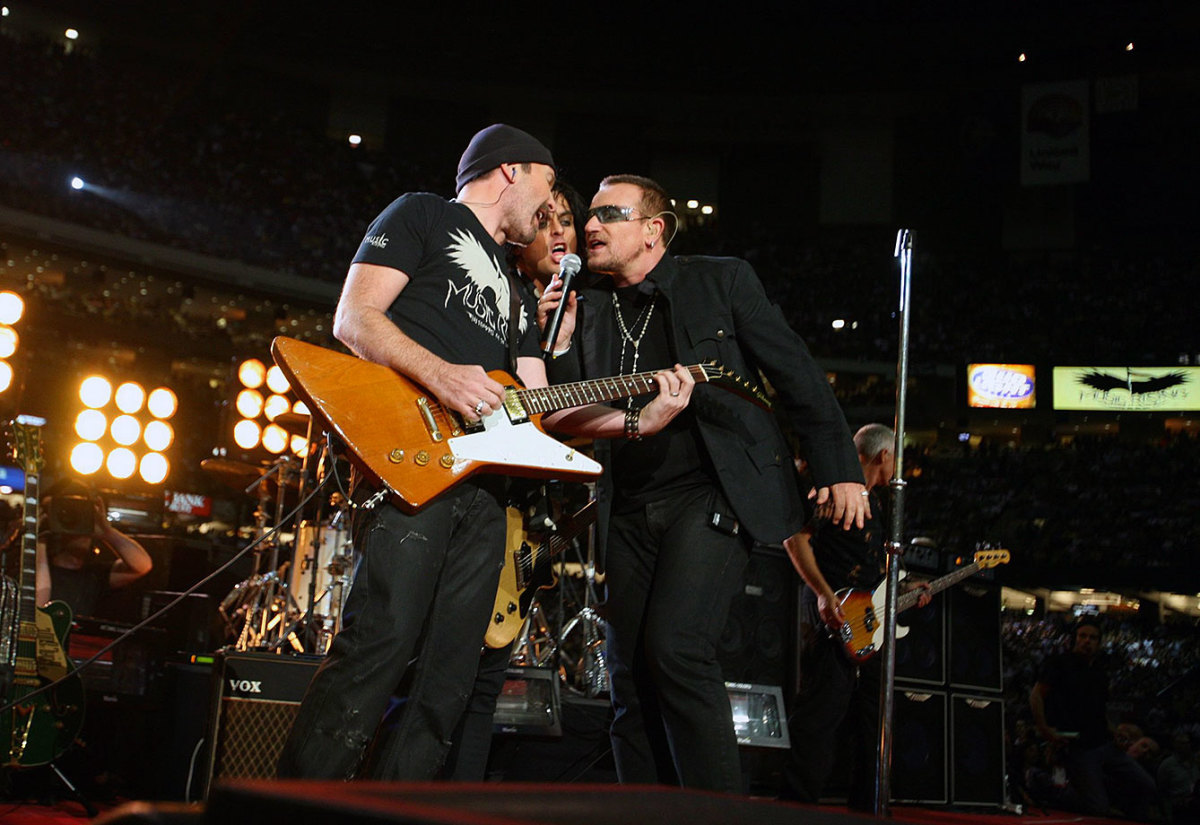
Sept. 25, 2006: U2 and Green Day perform before the Saints-Falcons game at the Superdome.
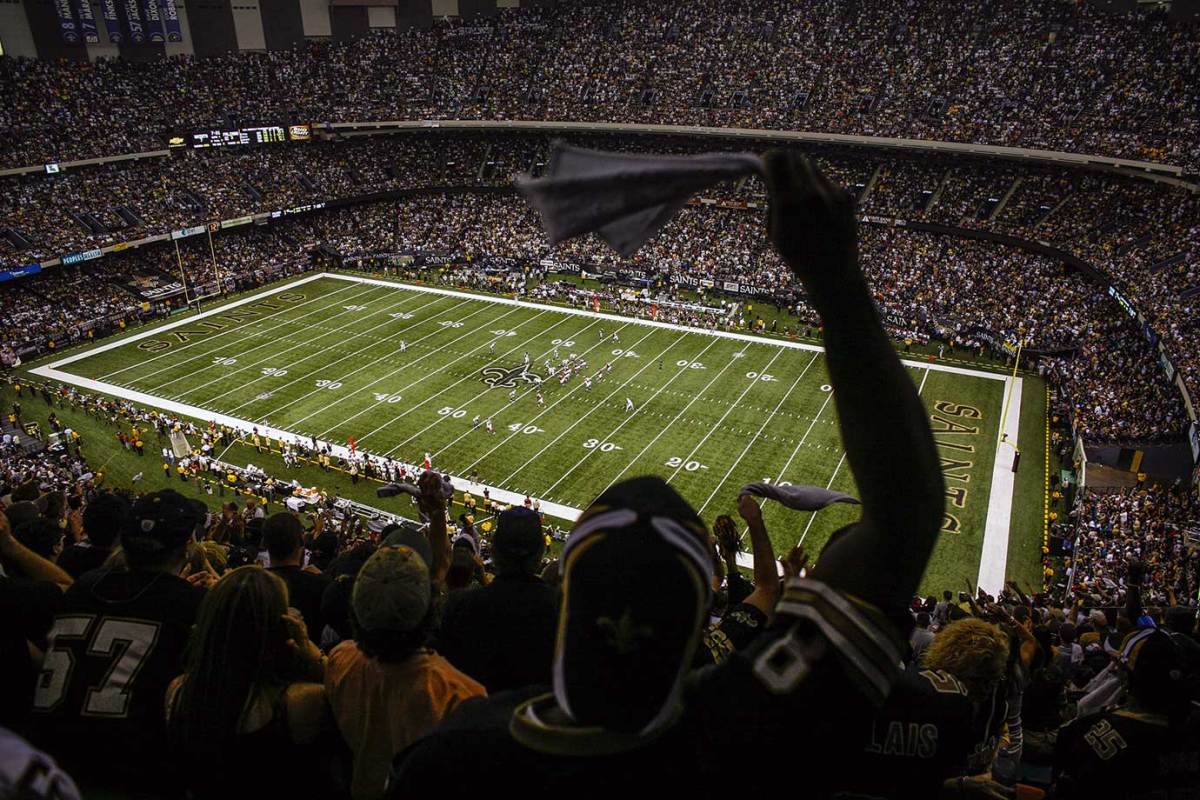
Sept. 25, 2006: Saints fans cheer during the team's first game back at the Superdome.
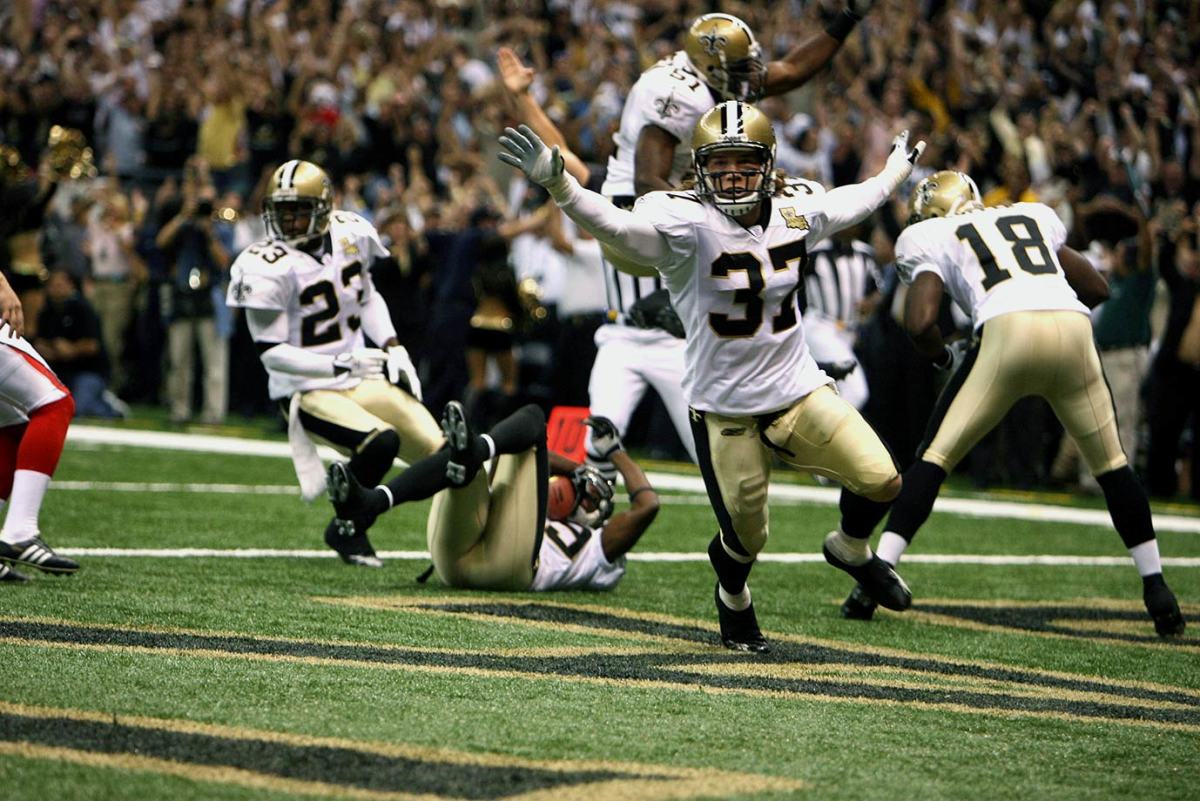
Sept. 25, 2006: Steve Gleason’s blocked punt that teammate Curtis Deloatch landed on in the end zone on just the fourth play of the game set the tone for the game and the season. The Saints beat their divisional rival Falcons that night 23–3.
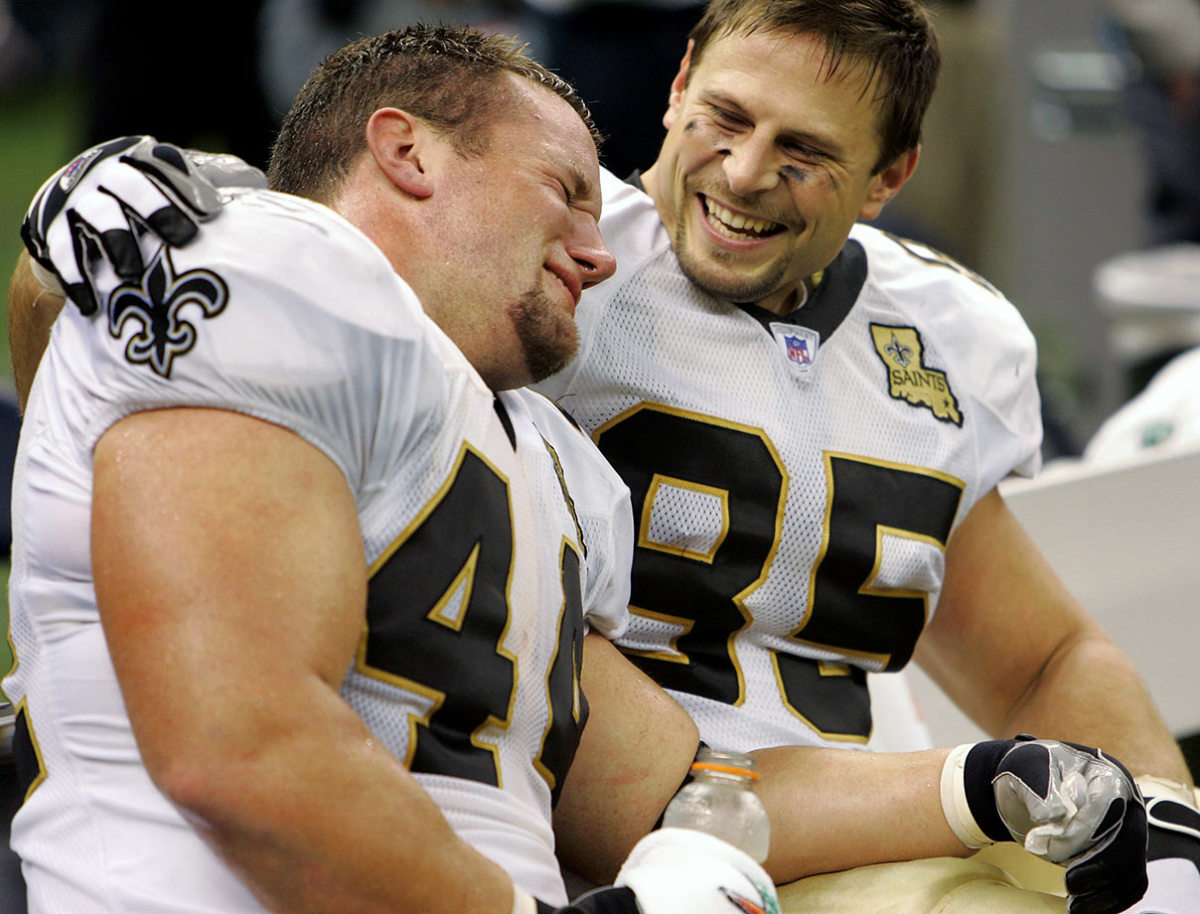
Sept. 25, 2006: Saints fullback Mike Karney is consoled by teammate tight end Ernie Conwell as he weeps at the end of the team's 23-3 win over the Atlanta Falcons.
‘Y’ALL CAN CARRY US HOME’
The next day was one of the heaviest I’ve ever experienced, and I’m pretty sure the same went for McAllister, too. When we hopped into the Astro Sunday morning it had a full tank of gas (rescue vehicles were able to avoid the gas lines of five hours or more that were now common across this part of Mississippi) and a proactive driver in Major Woodcock, whom I quietly nicknamed Major Leadfoot.
We passed trucks carrying caskets, generators and portable showers. As we proceeded past several road blocks and neared the city. Katrina’s wind damage became increasingly apparent. An Amtrak line had been utterly destroyed, and as we pulled onto Williams Blvd. in Metairie Major Leadfoot neatly dodged a mattress that was lying in the middle of the road.
The Saints’ facility, which FEMA had co-opted (apparently siphoning gas out of the cars in the parking lot, including McAllister’s black Hummer H2), seemed to have fared reasonably well, though one of the outdoor practice field’s goalposts had been mangled and wrestled to the ground, as if a swarm of jubilant college kids had stormed the grounds.
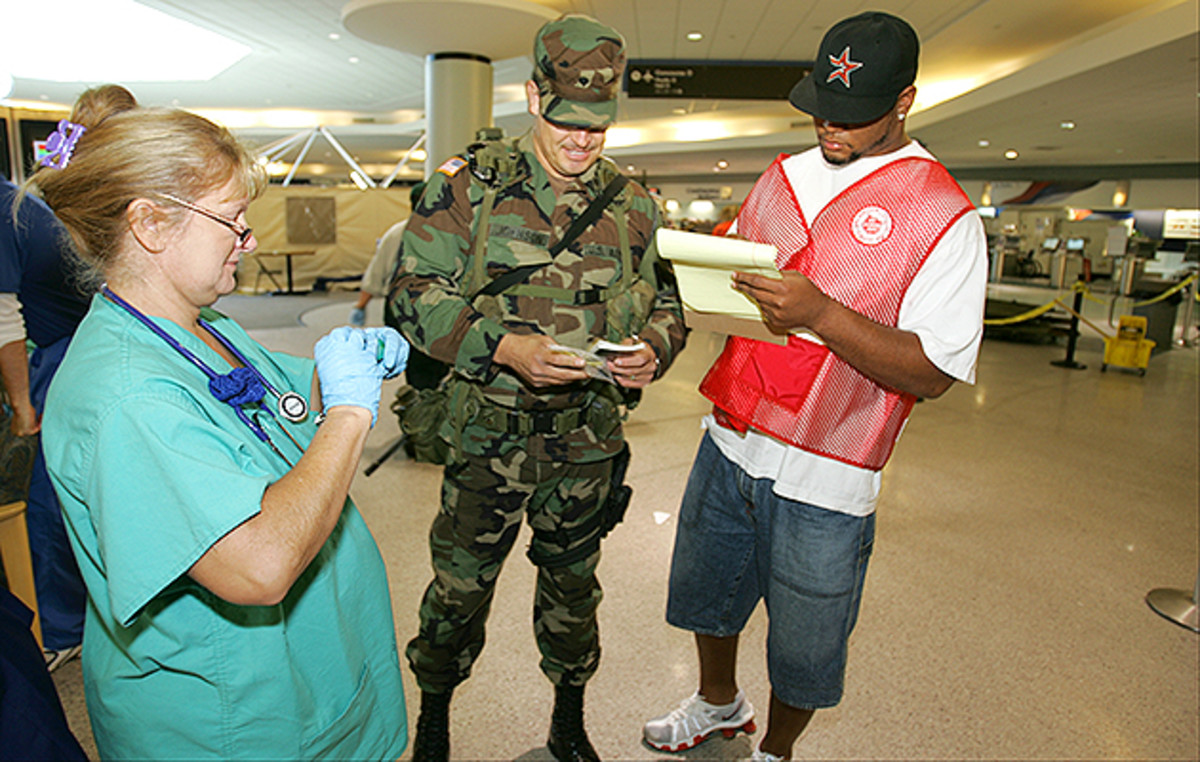
At the airport, we talked to Verrett, who said his plan was go to Houston and try to enroll Michael Jr. in school, then find a job to support his family. He believed his wife, Shaniel, and four other relatives had made it out safely but had no way to contact them. For what it’s worth, Verrett and some of his fellow evacuees weren’t as liberal in their attitudes toward looting as was Horn. “We saw a man coming down St. Claude Ave., which was flooded, with a 32-inch TV asking who wants to buy it,” one woman said. “We were like, ‘Man, who’s gong buy a 32-inch TV? What are you gonna do with that?”
Later, we saw a group of evacuees being helped out of a military chopper on the tarmac and loaded into one of those trucks normally used for baggage. It started off toward the terminal, but the driver braked suddenly after several people screamed. One of the evacuees had fallen out of the vehicle and onto the asphalt below. He was loaded into a wheelchair and taken to a triage area. “What is this, Day Seven?” McAllister asked rhetorically. “Think about what it was like on Day Two or Three.”
We drove off past a pair of blown out McDonald’s marquees and around the backside of the city and onto the Crescent City Connection bridge, which crosses the Mississippi River. From there we had a clear view of the skyline, complete with the burn-damaged River Walk shopping center and other landmarks like the French Quarter’s Jackson Square Brewery. Rescue helicopters buzzed over the heavily flooded areas to the east; a convoy of military trucks passed us on the otherwise abandoned road.
Our next stop was on Interstate 10 overlooking the infamous Calliope projects, with a view of the badly thrashed Superdome across the way. The streets near the projects were flooded; one woman emerged near what looked like a heavily damaged warehouse and waved her hands madly to get our attention. We tried to gesture to a helicopter up above, but the woman disappeared.
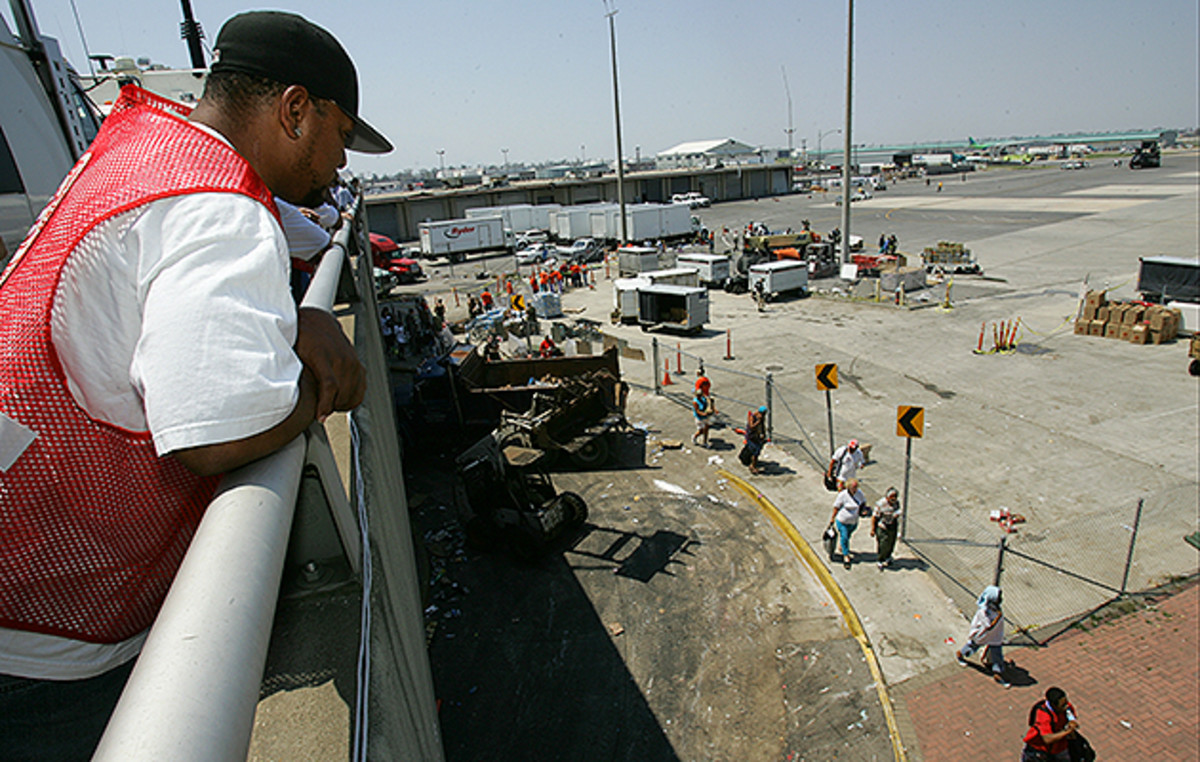
“Can you imagine being here at night, with no power, before the troops got here?” McAllister said.
A Caucasian man passed us on the other side of the freeway, walking with a backpack over his bare chest, a soiled shirt atop his head and a baseball bat in his left hand. Debris—discarded food wrappings and water bottles, old blankets, raggedly clothes, rubber boots, plastic milk crates, a teddy bear—lined the freeway’s shoulders. Until recently people had been sleeping here.
Up the road some more we stopped for a close-up view of the Superdome. Just below the stadium there was a waterlogged area, with cars submerged up to their hoods. We turned our heads and looked downward to an adjacent dry area. A large dog lay dead on his side while a live poodle scampered about, looking confused.
Forty pickup trucks sped by, each towing rescue boats. Around the corner several water-delivery trucks sat parked; they’d apparently been hijacked, their batteries stolen, their contents pilfered.
Proceeding to the portion of the freeway that overlooked the intersection of Canal and Claiborne, we got a clearer picture of the extent of the flooding. We began seeing stray residents, like the man living in the abandoned bus, who had no apparent desire to leave. One man paddled a small aluminum boat around the flooded area, seemingly trolling for family members, dead or alive.
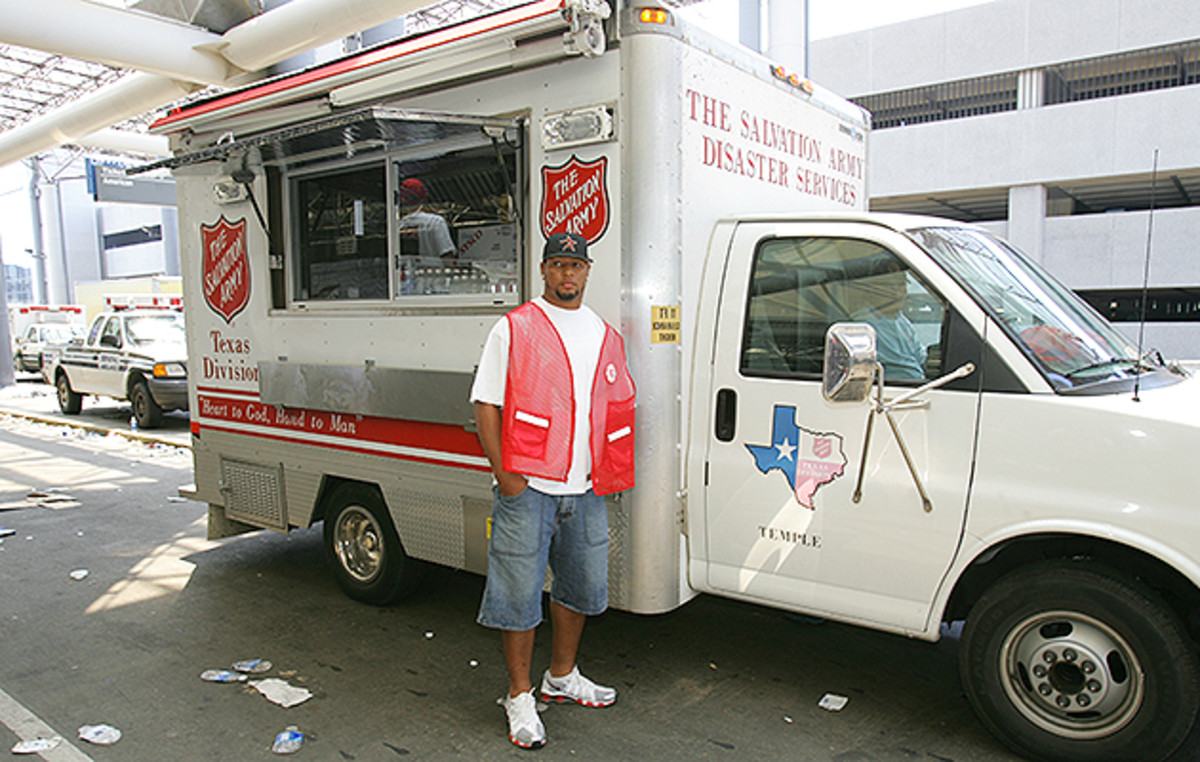
Other than the diamond stud in his right ear, McAllister, with his Nikes, denim shorts, white T-shirt, red mesh Salvation Army vest and black baseball cap, looked like just another rescue worker. Yet as we moved farther up the interstate, passing houses with green Xs marked atop the roofs (designating that a dead body, or bodies, lay inside), he was recognized by several recent evacuees who’d been dropped off by military trucks and now sat on the trash-littered shoulder, waiting for the helicopters to take them to the airport. The choppers landed behind us on the freeway—we weren’t going anywhere until they were, apparently—and as a little girl sucked her pacifier some of her family members talked football with McAllister.
McAllister stopped to speak to a young man in a black Yankees cap who was helping soldiers load a motionless man onto a stretcher. “I’m just trying to get my grandpa up out of here,” he said to McAllister. Then, he quickly added, “Hey, did y’all win that Raider game?”
Smiling, McAllister told him the Saints had lost. “Hey, that’s OK,” the man replied. “We’re going to the Bowl.”
Soon it was time for us to go, and after a quick stop at McAllister’s house in suburban Destrehan (across the street and down the block from Horn’s), where the damage was reasonably minimal, we headed back to Jackson, each of us keeping most of his thoughts to himself. A few hours later, as a private jet whisked us off to San Antonio—McAllister made Haslett’s 11 p.m. reporting deadline with a good seven minutes to spare—the running back and I finally debriefed.
We had met just three nights earlier, and now we had shared a journey that not only will remain indelibly etched in our memories, but which also gave us a surprising sense that pro football, for better or worse, does matter to some people, even under the most adverse of conditions.
“I got a text message earlier,” he said softly. “I don’t even know who sent it, but I want you to read it.” He handed me his cell phone and showed me the message: “Hope your family’s safe. You guys have the chance to raise a lot of devastated people’s spirits, put ‘em on your back. Y’all can carry us home.”
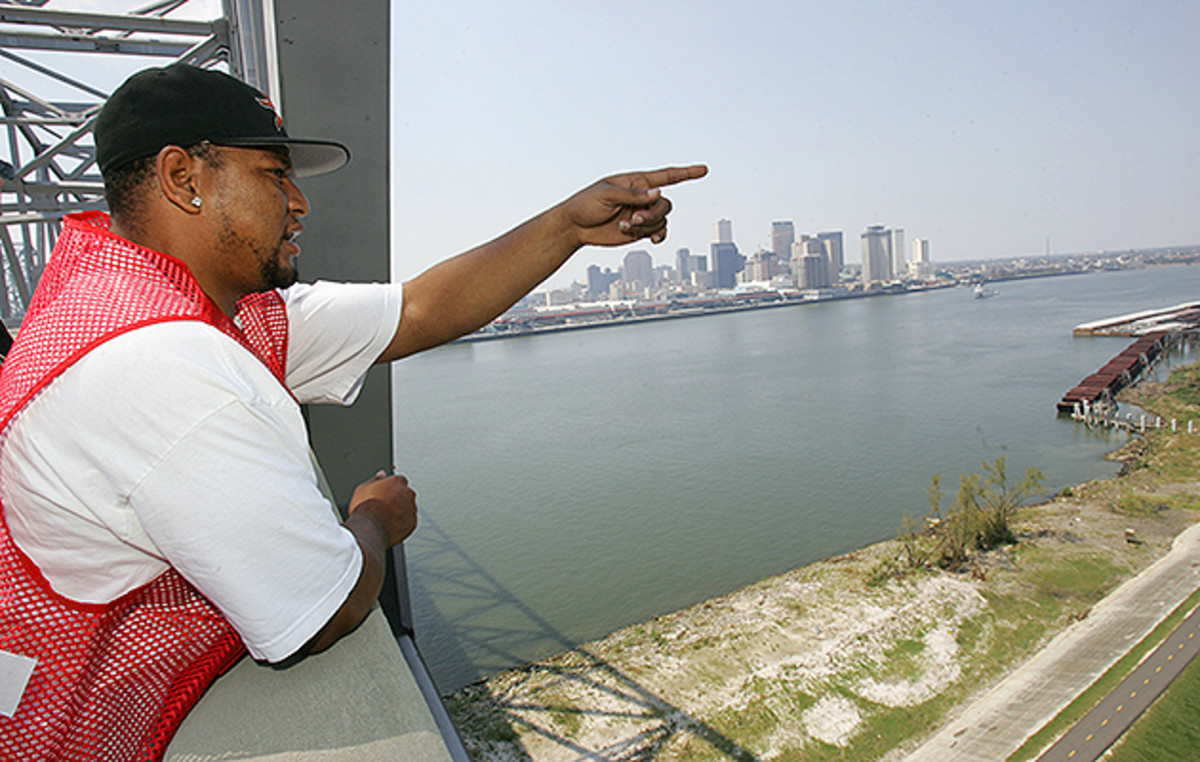
Whether the Saints ever again call New Orleans home remains uncertain, but right now, for the sake of these shell-shocked souls, I want to believe in my heart this franchise won’t be moved to San Antonio, L.A. or anywhere else. Against all odds, I want them to ignore their vagabond status and play with passion and precision and rise from the ranks of the perpetually mediocre. Not only would it be a great story, but I’m also convinced it would provide at least some small consolation—or, lacking that, harmless diversion—to a populace facing one of the greatest challenges that any U.S. metropolitan area’s residents have known.
“These people are pretty upbeat, considering everything they’ve been through,” McAfee had told me as we visited a shelter in Clinton, Miss., the previous day. “To see them smiling, when they’ve lost everything, is truly amazing. I want to go out there and play my heart out for these people. Football is something to hold onto, something that they know from before. Right now, it’s their lifeline, their connection to what was real—because what they’re experiencing is surreal.”
As the jet touched down, McAllister pocketed his phone and expressed a similar sentiment. “I can already hear the pregame speech I’m going to give to the team,” he said softly. “These people are truly diehards. That guy back there who was about to get on the helicopter, he’s hanging onto his life and he’s worried about what the Saints did against the Raiders? It’s very humbling.
“Seeing things like that, it makes me feel better about playing football. But it still doesn’t change anything. It’s Day Seven, and they’re still pulling people out. It’s very frustrating. It’s so sad. It’s going to take a long, long time to rebuild—and even longer for people to heal.”
